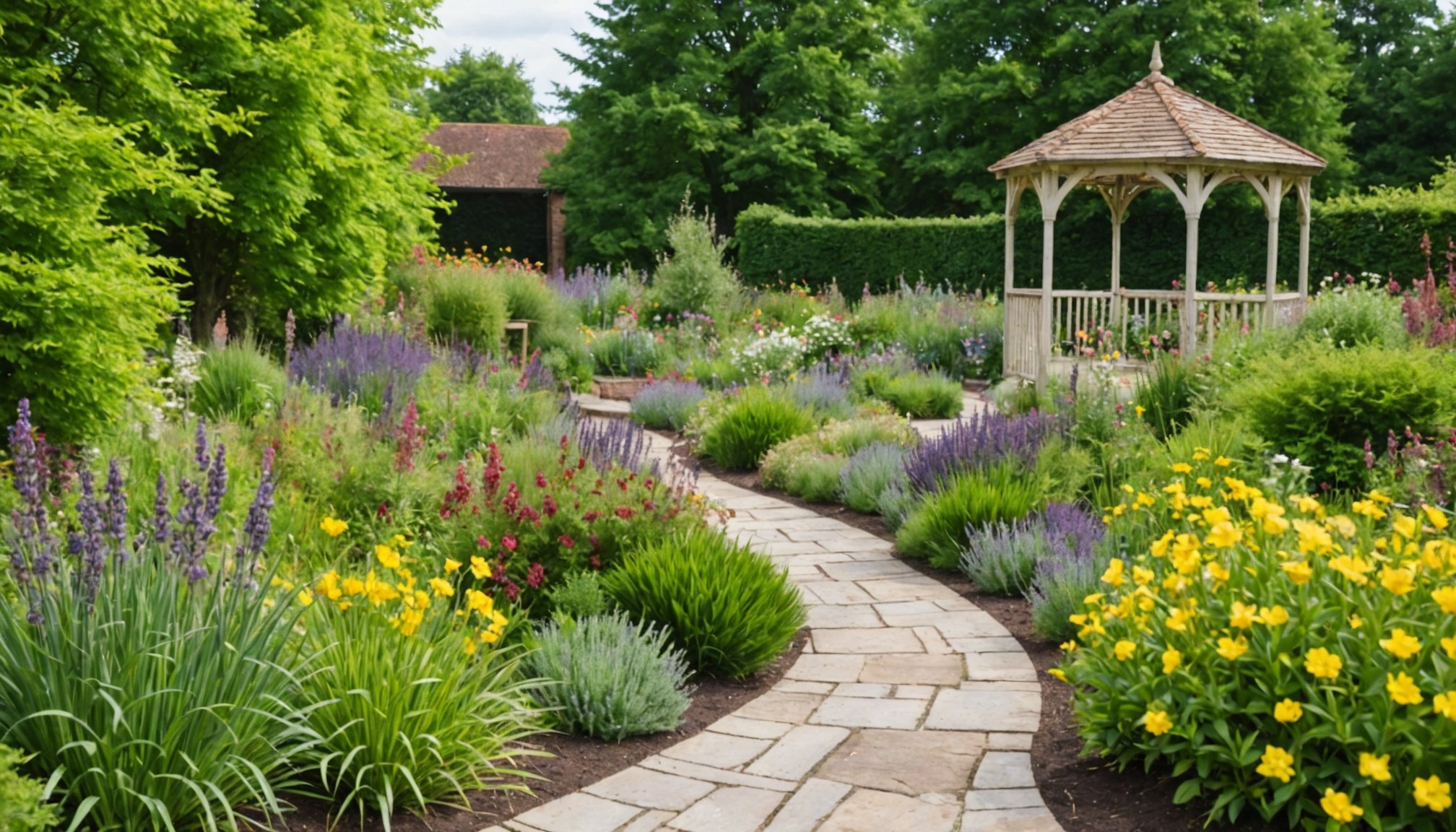With climate change intensifying, East Anglian gardens face the challenge of prolonged dry spells. Crafting a drought-resilient landscape can not only sustain your garden but also enhance its beauty and biodiversity. This guide offers expert tips tailored to your region’s unique conditions. From selecting the right plants to implementing effective watering strategies, discover practical solutions that will transform your garden into a thriving oasis, ready to withstand the dry days ahead. Embrace the opportunity to create a sustainable space that reflects your commitment to the environment.
Understanding Drought-Resilient Gardening
In the face of increasingly unpredictable weather patterns, drought-resistant gardening has become a vital practice, especially in regions like East Anglia. This area is known for its dry spells, making it crucial for gardeners to adapt to the climate challenges. But what exactly is drought resilience in gardening?
A découvrir également : Transforming Your Urban UK Garden: Innovative Ways to Achieve Privacy Without Fences
At its core, drought-resistant gardening involves selecting plants and implementing techniques that can thrive with minimal water. This is not just about plant selection; it also includes soil management and water conservation strategies. In East Anglia, where rainfall can be scarce, these practices help maintain vibrant gardens even during prolonged dry periods.
The East Anglia climate poses specific challenges due to its low rainfall and high evaporation rates. This makes water retention and efficient usage paramount. By understanding these climatic conditions, gardeners can make informed decisions about plant varieties and gardening techniques that are best suited for the region.
A découvrir également : Unlocking Indoor Plant Potential: Do LED Grow Lights Boost Growth in UK Homes?
Creating a drought-resilient garden offers numerous benefits. It conserves water, reduces maintenance, and enhances biodiversity. Moreover, it ensures that gardens remain lush and productive, even when water is scarce. Embracing drought-resistant gardening not only addresses immediate climate challenges but also contributes to sustainable environmental practices in the long run.
Selecting the Right Plants for Drought Resistance
Choosing the appropriate drought-tolerant plants is essential for creating a successful drought-resilient garden. These plants possess unique characteristics that allow them to survive with minimal water. Typically, they have deep root systems, waxy leaves, or the ability to store water, enabling them to thrive in dry conditions.
In East Anglia, selecting the right native plants is particularly beneficial, as these species are inherently adapted to the local climate. Some recommended native plants include the Common Rockrose, which is known for its vibrant yellow flowers, and the Field Scabious, which adds a touch of purple to your garden. Both are excellent choices due to their ability to withstand the region's dry spells.
To enhance drought resistance, consider strategic planting techniques. Grouping plants with similar water needs together ensures efficient water usage. Additionally, planting in the cooler months, such as autumn, allows plants to establish their root systems before the onset of summer heat.
By understanding the characteristics of drought-tolerant plants and opting for native species, gardeners can create a resilient and sustainable landscape. This approach not only conserves water but also supports local biodiversity, making it a win-win for both the environment and the gardener.
Soil Management for Optimal Water Retention
In drought conditions, soil management plays a crucial role in ensuring plants receive the necessary moisture. Healthy soil is the foundation of a drought-resilient garden, as it enhances the water retention capabilities essential for plant survival during dry spells.
Techniques for Improving Soil Structure
Improving soil structure is pivotal for water retention. One effective method is incorporating organic amendments such as compost, which increases the soil's ability to hold moisture. Compost enriches the soil with nutrients, enhancing its fertility and promoting robust plant growth. Another technique involves using mulch to cover the soil surface. Mulch not only reduces evaporation but also regulates soil temperature and suppresses weed growth.
Organic Amendments for Water Retention
Organic materials like peat moss and well-rotted manure are excellent for boosting water retention. These amendments improve soil texture by increasing its porosity, allowing it to hold more water. Additionally, adding biochar can enhance soil structure and fertility, making it a valuable component in drought-resistant gardening.
By focusing on soil health and employing these water retention techniques, gardeners can create an environment where plants can thrive even in challenging conditions. This approach not only conserves water but also supports the overall sustainability of the garden ecosystem.
Efficient Watering Techniques
Ensuring that your drought-resistant garden thrives relies heavily on adopting efficient watering techniques. These practices not only conserve water but also enhance plant health by delivering moisture effectively.
Best Practices for Watering
Timing is crucial when it comes to watering. The optimal time to water your garden is early in the morning or late in the afternoon. This reduces evaporation, ensuring that more water reaches the plant roots. Frequency should be adjusted based on plant needs and weather conditions. Deep, infrequent watering encourages deep root growth, making plants more resilient to drought.
Tools and Systems for Efficient Irrigation
Investing in proper tools can significantly improve water conservation. Drip irrigation systems are highly effective as they deliver water directly to the plant base, minimizing wastage. Soaker hoses are another excellent option, providing a slow and steady water supply. For those who prefer traditional methods, watering cans with rose heads can help distribute water evenly without over-saturating the soil.
By incorporating these watering techniques, gardeners can maintain a lush and sustainable garden, even in the driest conditions. Adapting these methods not only supports plant health but also contributes to the broader goal of water conservation.
Designing a Drought-Resilient Landscape
Creating a drought-resilient landscape goes beyond plant selection; it involves strategic landscape design principles that focus on sustainability. By embracing these principles, gardeners can craft a garden that thrives even in dry conditions.
Principles of Sustainable Landscape Design
Sustainable gardening begins with understanding the principles of sustainable landscape design. This includes selecting native plants, reducing lawn areas, and using permeable materials to enhance water infiltration. These practices not only conserve water but also create a balanced ecosystem that supports local biodiversity.
Creating Zones and Microclimates
Designing your garden with specific zones and microclimates can optimize water usage. By grouping plants with similar water needs together, you create zones that allow for efficient watering. Incorporating elements like trees and shrubs can provide shade, reducing evaporation and creating cooler microclimates that benefit other plants.
Incorporating Hardscapes to Reduce Water Usage
Hardscapes, such as gravel paths, stone patios, and raised beds, are integral to sustainable gardening. These features minimize water usage by reducing the need for irrigation. Additionally, they add aesthetic value and functionality, allowing for a practical and visually appealing garden layout.
By integrating these sustainable landscape design strategies, gardeners can effectively manage water resources and create a resilient, thriving garden.
Utilizing Mulch and Ground Covers
In the realm of drought-resistant gardening, mulch and ground covers play pivotal roles in enhancing water conservation and soil health. These elements are not just aesthetic additions but integral components of a sustainable garden.
Role of Mulch in Water Conservation
Mulch acts as a protective layer over the soil, reducing evaporation and maintaining moisture levels. By covering the soil, mulch minimizes the impact of direct sunlight and wind, both of which can rapidly deplete soil moisture. This conservation of water is crucial in dry regions like East Anglia, where every drop counts.
Types of Mulch Suitable for East Anglia Gardens
Selecting the right type of mulch is essential for maximizing its benefits. Organic mulches, such as wood chips, straw, and bark, are excellent choices as they decompose over time, enriching the soil with nutrients. Inorganic mulches like gravel and stone are also effective, offering long-lasting coverage without the need for frequent replacement.
Benefits of Ground Covers in Preventing Soil Erosion
Ground covers serve as living mulches, offering additional benefits. They protect the soil from erosion by anchoring it with their roots. Moreover, ground covers help suppress weeds, reducing competition for water and nutrients. By incorporating both mulch and ground covers, gardeners can create a robust and resilient landscape.
Xeriscaping as a Sustainable Gardening Practice
Xeriscaping is a gardening method designed to reduce or eliminate the need for supplemental water from irrigation. This sustainable practice is particularly beneficial in regions prone to drought, such as East Anglia. The principles of xeriscaping focus on using native, drought-tolerant plants and efficient landscaping techniques to conserve water and create a resilient garden ecosystem.
Steps to Implement Xeriscaping in Your Garden
To begin implementing xeriscaping, start by assessing your garden's natural conditions, including soil type, sunlight, and existing vegetation. Choose plants that are well-suited to these conditions and require minimal watering. Incorporating mulch and ground covers helps retain soil moisture and reduce evaporation, aligning with xeriscaping principles.
Design your landscape to enhance water efficiency by creating zones of plants with similar water needs. Utilize hardscapes like gravel paths and stone patios to reduce water usage and add aesthetic appeal. Efficient watering systems, such as drip irrigation, further support the xeriscaping approach by minimizing water waste.
Examples of Successful Xeriscaping in East Anglia
In East Anglia, xeriscaping has been successfully implemented in various public and private gardens. These landscapes often feature native plants like the Common Rockrose and Field Scabious, which thrive in the region's dry climate. By adopting xeriscaping, gardeners in East Anglia can achieve sustainable, water-efficient gardens that flourish even during prolonged dry spells.
Local Resources and Community Support
In East Anglia, tapping into local gardening resources and engaging with community support can significantly enhance your drought-resilient gardening efforts. Local gardening organizations offer a wealth of knowledge and tools to help gardeners adapt to the region's unique climate challenges.
Overview of Local Gardening Organizations and Resources
East Anglia boasts several gardening organizations dedicated to promoting sustainable practices. These groups provide resources such as plant libraries, seed exchanges, and educational materials focused on drought resilience. By joining these organizations, gardeners can access expert advice and stay informed about the latest techniques in water conservation and soil management.
Networking Opportunities with Local Gardeners
Connecting with fellow gardeners through community networks fosters the exchange of ideas and experiences. Local gardening clubs and online forums offer platforms for sharing tips on drought-resistant plants and efficient watering techniques. Through these interactions, gardeners can learn from each other's successes and challenges, building a supportive community.
Workshops and Events Focused on Drought Resilience
Participating in workshops and events organized by local gardening groups provides hands-on learning experiences. These events often cover topics such as xeriscaping, soil improvement, and efficient irrigation systems. Attending these workshops enables gardeners to gain practical skills and insights, empowering them to create sustainable, drought-resilient landscapes.
Visual Aids and Tools for Drought-Resilient Gardening
In the quest for a thriving drought-resistant garden, the right gardening tools and visual aids can make all the difference. These resources streamline the gardening process, ensuring efficiency and success in challenging climates.
Recommended Tools for Drought-Resistant Gardens
Investing in high-quality gardening tools is crucial. Essential items include moisture meters to monitor soil hydration, and drip irrigation systems for precise water delivery. A sturdy hoe or cultivator assists in maintaining soil structure, while a mulching mower helps in recycling garden waste into valuable mulch.
Utilizing Visual Aids Such as Charts and Diagrams
Visual aids, like charts and diagrams, offer invaluable guidance in planning and maintaining your garden. Planting charts can help determine the best planting times, while water usage diagrams illustrate efficient irrigation techniques. These aids simplify complex information, making it accessible and actionable for gardeners of all experience levels.
Online Resources and Apps for Garden Planning
Harnessing technology can enhance garden planning. Apps like Garden Planner provide customized layouts and plant recommendations based on local climate data. Online platforms offer a plethora of resources, from detailed plant care guides to interactive community forums. These tools empower gardeners to make informed decisions, ensuring a resilient and sustainable garden.
Case Studies of Successful Drought-Resilient Gardens
Exploring case studies of successful drought-resilient gardens provides valuable insights into effective gardening practices. In East Anglia, several gardens have become exemplary models of how to thrive under dry conditions.
One notable success story is the garden at Wisbech, where gardeners have strategically used native plants like the Common Rockrose and Field Scabious. These plants, known for their drought tolerance, are complemented by efficient watering systems such as drip irrigation. The garden also utilizes mulch extensively to retain moisture, showcasing how these techniques collectively create a sustainable landscape.
From these case studies, several lessons can be drawn. First, the importance of plant selection is emphasized, highlighting the need to choose species that are naturally adapted to the local climate. Second, the role of soil management and water conservation techniques is crucial in maintaining plant health during dry spells.
Experienced gardeners in East Anglia offer inspiration and tips for those looking to adapt their gardens. They recommend starting small, experimenting with different plants, and gradually integrating water-saving practices. By learning from these successful gardens, others can implement similar strategies, ensuring their own gardens flourish despite challenging conditions.











